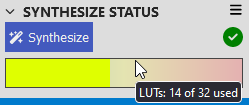3 The Synthesis Process, Status and Outputs
Understanding the synthesis process and interpreting its results.
3.1 Status of the Synthesis Process
Understanding the synthesis status indicator.
A synthesis process converts a logic design into bitstream form, which can be loaded into the CLB. Clicking the Synthesize button will trigger this.
The status indicator and the resource view indicate the outcome of the synthesis process.
Successful Synthesis
A green indicator will show when the synthesis succeeds - and the resource view is updated.

Failed Synthesis
A red indicator will show when synthesis has failed.

The nature of the failure can be determined by:
- Checking the Design checker or Notifications panels for warnings about unconnected pins
- Checking the Synthesis panel for output from the backend synthesis process
- Downloading the ZIP and checking the backend log output, which must also be included when consulting Microchip support channels
3.2 Synthesis Outputs
Additional outputs other than the bitstream.
The primary output of the Synthesis process is the bitstream. However, there are additional outputs in the ZIP file which may be useful.
Two diagrams are produced during synthesis and displayed in the output panel on the left sidebar.

pre-routing.svg
This diagram shows a presentation of your logic design after YoSYS has processed it but before mapping it into CLB-specific resources.
In this example, the three inputs are presented to the 3-input LUT3 via nodes mapping 'P' to 'O' and the output of the LUT connected to PPS_OUT0 via a node mapping 'I' to 'P'. These nodes are virtual connections unmapped onto hardware resources.

routed.svg
This diagram shows a representation of your logic as it will be implemented on the actual CLB hardware using its available resources.
- CLBIN1PPS is connected directly to the A input of the LUT
- PWM1_OUT is connected via BLE9 to the B input of the LUT (as shown by the expression 'O = A')
- CLBIN0PPS is connected via BLE18 to the C input of the LUT (as shown by the expression 'O = A')
- The logic expression is performed by BLE6 and its logic expression is O = 'C + 'A + B
- The LUT output is connected to PPS_OUT0 via BLE2

Flip-flops are labeled with DFF in the diagrams.

By counting the number of BLEs that the logic signals pass through between synchronization points (flip-flops) it is possible to estimate a safe operating frequency for the logic design in conjunction with timing information in the device data sheet.
3.3 Resource Usage Debugging
Enter a short description of your topic here (optional).
- Try to use alternative outputs (e.g., change IRQ0 to IRQ1)
- Try to remove some logic functionality
- Check that there are no unused modules included in the documents
- Check that there are no logic functions with pre-determined outputs (e.g., a constant zero as an input to an AND gate)
Include the ZIP file returned from the failing synthesis process when contacting Microchip support.
